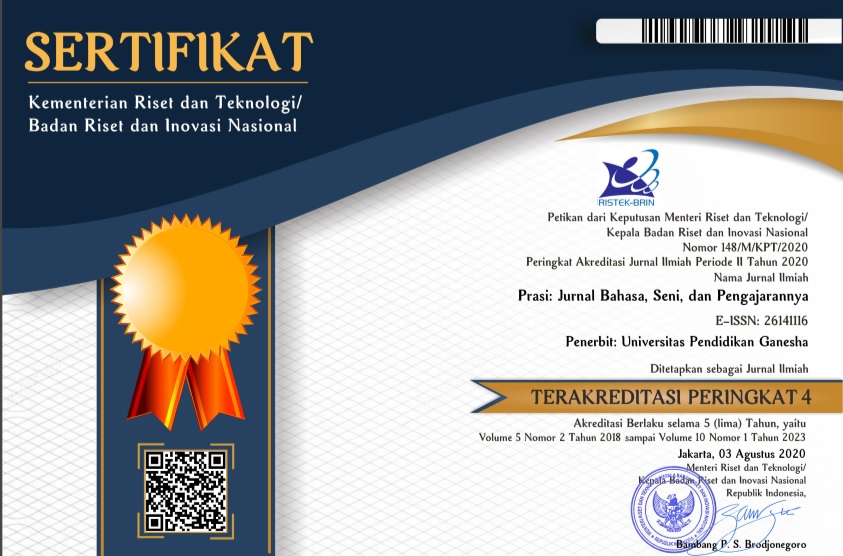LEXICONS OF TABUH RAH USED IN MENYALI VILLAGE
DOI:
https://doi.org/10.23887/prasi.v15i02.26906Keywords:
Language maintenance, Tabuh Rah ceremony, Tabuh Rah lexiconsAbstract
This study investigated the lexicons used in Tabuh Rah ceremony in Menyali village. This research was designed in the form of descriptive qualitative study. The focus of this study was to find out lexicons that exist in Tabuh Rah ceremony in Menyali village. The data of this study were obtained by conducting observation and interview with three informants who were from from Menyali village. The object of this study was Tabuh Rah lexicons that exist in Menyali village. The result of this study shows that there were seventy-one lexicons existing in Tabuh Rah ceremony in Menyali village. Those seventy-one lexicons were grouped based on their categories, including twelve lexicons which were concerned with series of events, fifteen lexicons dealt with Tabuh Rah facilities, six lexicons were found in roles in Tabuh Rah, three lexicons concerned with Tabuh Rah arena, four lexicons had something to do with kinds of offerings, twelve lexicons related to types of cocks, six lexicons dealt with types of taji pairings and thirteen lexicons were concerned with betting codes. All of the lexicons had their own meaning and function in the ceremony. The villagers kept using Tabuh Rah lexicons during the ceremony in order to maintain the language, especially maintaining Tabuh Rah lexicons in Menyali village.
Keywords: Language maintenance, Tabuh Rah ceremony, Tabuh
References
Abdelhadi, M. (2017). Language maintenance factors: reflections on the Arabic langauge. Asia Pasific Conference Contemporary Research. https://apiar.org.au/wp-content/uploads/2017/10/16_APCCR_2017_BRR742_SS-110-121.pdf retrieved 14th July 2020.
Adityarini, I. A. P. (2016). Khazanah Leksikon Budaya Kepatungan di Desa Kemenuh Gianyar: kajian ekolinguistik. Denpasar: Udayana University Press.
Angel, W. W. (2019). Tabuh Rah pada Ritual Yajna Masyarakat Bali di Desa Balinuraga Kecamatan Way Panji Kabupaten Lampung Selatan. Bandar Lampung: Universitas Lampung.
Budasi, G. I., Tantra, D. K., Wahyuni, L. G. E. (2016). Leksikon Bahasa Bali dalam Budaya ‘Bale Gede’ di Desa Menyali Kecamatan Sawan Kabupaten Buleleng Kajian Ekolinguistik. Universitas Pendidikan Ganesha: Singaraja.
Giri, I. M. A. (2017). Pelestarian Bahasa, Aksara, dan Sastra Bali Melalui Pengoptimalan Tripusat Pendidikan. PURWADITA, 1 (1), 27 -32.
Habtoor, H. A. (2012). Language maintenance and language shift among second generation Tigrinya-Speaking Eritrean immigrants in Saudi Arabia. Theory and Practice in Language Studies, 2(5), 945-955.
Hestiyana. (2017). Leksikon dan Makna Kultural Kain Khas Banjar Sasirangan. Dalam Isu-isu Muktahir Linguistik: Makalah Seminar Nasional, pages. 255-266. Yogyakarta: Departemen Bahasa dan Sastra Fakultas Ilmu Budaya, Universitas Gadjah Mada.
Holmes, J. (2013). An Introduction to Sociolinguistics . New York: Routledge.
Kniten, I. P. P.P & Gunanta, I. N. (2005). Tinjauan Tabuh Rah dan Judi. Surabaya: PARAMITA.
Kridalaksana, H. (2011). Kamus Linguistik. Jakarta: Gramedia.
Kurniati, I. (2014). Sociolinguistics Analysis of Code Mixing on Nine Summer Ten Autumns Novel by Iwan Setiawan. Jakarta: Faculty of Adab and Humanities. State Islamic University Syarif Hidayatullah.
Miles, M. B. & Huberman, A. M. (1994). Qualitative Data Analysis. London: Sage Publications.
Rai, I. B., Wisnu, I. W. G., Purnami, I. A. P., Sriasih, S. A. P. (2016). Analisis Campur Kode Pada Wacana Bahasa Bali. Prasi, 11 (01), 30-40.
Rijal, S. (2016). Hubungan Bahasa Dayak Kenyah dan Bahasa Dayak Punan: Analisis Ekolinguistik Dialektikal. Denpasar: Udayana University Press.
Suastika, I. N. (2015). Tajen: tradition legitimacy of cockfights gambling (theoretical study of cockfighting gambling in perspective of national law and Bali customary law). South East Asia Journal of Contemporary Business, Economics and Law, 6 (4), 15-19.
Sugiyono, S. (2017). Metode Penelitian Kualitatif. Bandung: Alfabeta.
Sutama, P. (2011). Ancaman Kepunahan/Pemunahan Kosa Kata Bahasa Bali dalam Ranah Permainan Judi Tajen Perspektif Linguistik Kebudayaan. KIMLI, 143 - 146.
Tarigan, B. & Sofyan, R. (2018). Maintaining Karonese Ecolexicon Through Traditional Game Cengkah-Cengkah. Internation Journal of Applied Linguistics & English Literature, 7 (4), 177-183.
Downloads
Published
Issue
Section
License
Authors who publish with Prasi agree to the following terms:- Authors retain copyright and grant the journal the right of first publication with the work simultaneously licensed under a Creative Commons Attribution License (CC BY-SA 4.0) that allows others to share the work with an acknowledgment of the work's authorship and initial publication in this journal
- Authors are able to enter into separate, additional contractual arrangements for the non-exclusive distribution of the journal's published version of the work (e.g., post it to an institutional repository or publish it in a book), with an acknowledgment of its initial publication in this journal.
- Authors are permitted and encouraged to post their work online (e.g., in institutional repositories or on their website) prior to and during the submission process, as it can lead to productive exchanges, as well as earlier and greater citation of published work. (See The Effect of Open Access)


.png)
.png)









